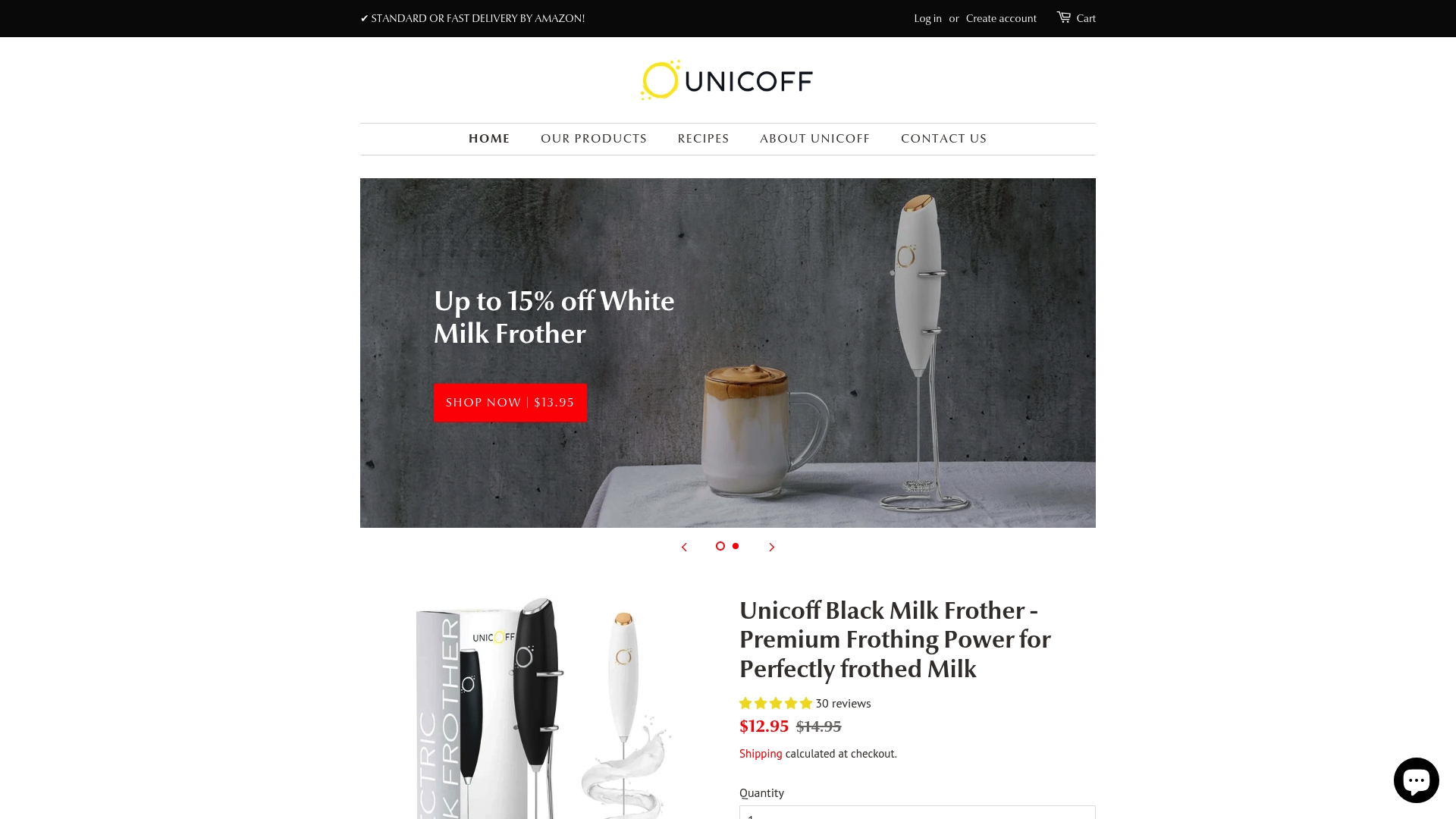Milk frothers are popping up in kitchens everywhere, turning simple cups of coffee into café masterpieces at home. Most people think a great coffee comes down to the beans or brewing method, but here’s a shock. The real secret sits in the foam, and the right frother can boost milk’s volume by up to 3 times its original size. That means anyone can make rich, silky lattes at home without a single trip to the coffee shop.
Table of Contents
- What Are Milk Frothers And Their Types?
- Why Milk Frothers Matter In Coffee Making
- How Milk Frothers Work: The Science Behind Frothing
- Key Concepts In Milk Frothing For Perfect Coffee
- Real-World Impact Of Milk Frothers On Coffee Culture
Quick Summary
| Takeaway | Explanation |
|---|---|
| Choose the right frother type | Select between manual, handheld electric, or automatic frothers based on your needs and budget. |
| Understand milk frothing science | Knowledge of protein interactions influences frothing quality, enhancing coffee texture and flavor. |
| Experiment with milk types | Different milk compositions affect foam quality; adapt techniques accordingly for best results. |
| Control temperature for optimal frothing | Ideal frothing occurs between 140F and 160F for maximum protein responsiveness. |
| Elevate home coffee preparation | Use advanced frothing techniques to replicate café quality beverages at home effortlessly. |
What are Milk Frothers and Their Types?
Milk frothers represent essential kitchen tools transforming ordinary coffee into professional barista-style beverages by creating rich, creamy milk foam. Explore our range of professional milk frothers to elevate your home coffee experience.
Understanding Milk Frothers
A milk frother is a specialized device designed to aerate and create foam from milk through mechanical agitation. These devices work by introducing air into milk proteins, causing them to expand and create a light, velvety texture perfect for cappuccinos, lattes, and other specialty coffee drinks. According to HandWiki’s engineering overview, milk frothers can be categorized into three primary types:
- Manual frothers using a perforated mesh plunger
- Handheld electric frothers powered by batteries
- Automatic electric frothers with integrated heating mechanisms
Types of Milk Frothers
Each milk frother type offers unique advantages for coffee enthusiasts.
 Manual frothers require physical effort, utilizing a plunger mechanism to whip milk into foam. These are typically more affordable and provide greater control over the frothing process. Handheld electric frothers use battery-powered whisks that spin rapidly, creating consistent foam with minimal user effort. Automatic frothers represent the most advanced option, featuring built-in heating elements that simultaneously warm and froth milk at precise temperatures.
Manual frothers require physical effort, utilizing a plunger mechanism to whip milk into foam. These are typically more affordable and provide greater control over the frothing process. Handheld electric frothers use battery-powered whisks that spin rapidly, creating consistent foam with minimal user effort. Automatic frothers represent the most advanced option, featuring built-in heating elements that simultaneously warm and froth milk at precise temperatures.
The choice of milk frother depends on individual preferences, budget, and desired level of convenience. Home baristas might prefer manual options for hands-on experience, while busy professionals might opt for automatic devices that deliver quick, consistent results.
Below is a comparison table summarizing the main types of milk frothers, highlighting their mechanisms, advantages, and ideal users.
| Milk Frother Type | Mechanism | Key Advantages | Ideal Users |
|---|---|---|---|
| Manual Frother | Plunger with mesh screen | Affordable, full user control | Hands-on home baristas |
| Handheld Electric | Battery-powered spinning whisk | Quick, consistent, portable | Casual coffee drinkers |
| Automatic Frother | Electric, integrated heating | Heats & froths simultaneously, easy | Busy professionals, beginners |
| Understanding these variations helps coffee lovers select the most suitable tool for creating delightful, cafe-quality beverages right in their kitchen. |
Why Milk Frothers Matter in Coffee Making
Milk frothers play a transformative role in elevating home coffee experiences from ordinary to extraordinary. Discover our premium milk frothers designed to revolutionize your daily brewing ritual.
The Science of Milk Transformation
The critical importance of milk frothers lies in their ability to fundamentally alter milk’s molecular structure. According to research in the Journal of Dairy Science, milk frothing involves complex protein interactions that create stable emulsions. When air is mechanically introduced into milk, proteins like casein and whey unfold and create a network of tiny air bubbles, resulting in a smooth, creamy texture that enhances coffee drinks.
Enhancing Flavor and Texture
Milk frothers are not merely aesthetic tools but essential instruments for creating multilayered sensory experiences. Proper milk frothing produces microfoam with microscopic bubbles that integrate seamlessly with espresso, creating harmonious flavor profiles. The foam acts as a natural sweetener, softening espresso’s intense notes and providing a luxurious mouthfeel. Different frothing techniques yield varied results:
- Thin, delicate foam for traditional cappuccinos
- Dense, rich foam for latte art
- Lightweight, airy foam for macchiatos
Professional Quality at Home
Home baristas can now replicate cafe-quality beverages through advanced milk frothing techniques. By understanding milk protein dynamics and using precision tools, anyone can transform simple ingredients into gourmet coffee experiences. The right milk frother bridges the gap between amateur and professional brewing, offering consistent results that elevate everyday coffee consumption into a refined culinary practice.
How Milk Frothers Work: The Science Behind Frothing
Milk frothing represents a fascinating intersection of physics, chemistry, and culinary art. Check out our advanced milk foam makers designed to perfect this intricate process.
Molecular Mechanics of Milk Frothing
At its core, milk frothing is about transforming liquid milk into a light, voluminous foam through precise mechanical intervention. According to research from Louisiana State University, multiple factors influence milk’s frothing capabilities, including protein composition, fat content, and temperature. Milk proteins like casein and whey play a crucial role in creating stable foam structures by unfolding and forming complex networks that trap air bubbles.
Key Protein Interactions
When a milk frother introduces mechanical agitation, it triggers a complex molecular dance. The process involves several critical steps:
- Protein denaturation: Milk proteins change their structural configuration
- Air incorporation: Mechanical whisking introduces microscopic air bubbles
- Bubble stabilization: Protein networks create a stable foam structure
Temperature and Technique Dynamics
Temperature significantly impacts milk frothing performance. Optimal frothing typically occurs between 140F and 160F, where milk proteins are most responsive to mechanical agitation. Different milk types produce varied results:
- Whole milk creates rich, creamy foam with higher fat content
- Skim milk produces lighter, more voluminous foam
- Plant based milks have unique protein structures requiring specialized techniques
Understanding these scientific principles transforms milk frothing from a simple kitchen task into a precise culinary technique, allowing home baristas to create professional quality beverages with consistent, exceptional results.
Key Concepts in Milk Frothing for Perfect Coffee
Achieving barista-quality coffee at home requires understanding fundamental milk frothing principles. Learn more about latte artistry techniques and elevate your home brewing skills.
Milk Composition and Frothing Potential
The secret to exceptional milk frothing lies in understanding milk’s complex molecular structure. According to research in the Journal of Food Engineering, milk’s foaming capabilities depend on intricate interactions between proteins, fats, and mechanical processes. Protein concentration plays a critical role in creating stable, long-lasting foam structures.
Critical Frothing Parameters
Successful milk frothing involves mastering several key parameters that directly impact foam quality:
- Milk temperature: Optimal range between 140F and 160F
- Protein concentration: Higher protein content creates more stable foam
- Fat content: Influences foam richness and texture
- Mechanical agitation technique: Determines bubble size and stability
Milk Type Variations
Different milk varieties present unique challenges and opportunities for frothing. Understanding these variations allows home baristas to adapt their techniques:
- Whole milk: Produces rich, creamy foam with superior texture
- Skim milk: Creates lighter, more voluminous foam with less fat
- Non-dairy alternatives: Require specialized frothing techniques due to different protein structures
Mastering these key concepts transforms milk frothing from a simple kitchen task into a precise culinary art, enabling coffee enthusiasts to create professional-quality beverages with consistent, exceptional results.
This table outlines how different types of milk influence the characteristics of frothed foam, based on their protein and fat content as explained in the article.
| Milk Type | Protein Content | Fat Content | Froth Characteristics | Special Considerations |
|---|---|---|---|---|
| Whole Milk | Moderate | High | Rich, creamy, best texture | Ideal for classic lattes/cappuccinos |
| Skim Milk | High | Low | Light, voluminous foam | Best for airy foam, less richness |
| Plant-based Milk | Variable | Variable | Varies, less stable, needs technique | Specialized methods may be required |
Real-World Impact of Milk Frothers on Coffee Culture
Milk frothers have transformed home brewing from a mundane task into a creative culinary experience. Explore professional home brewing techniques and revolutionize your daily coffee ritual.
Democratizing Professional Coffee Experiences
According to research from the American Chemical Society, milk frothers have significantly democratized professional coffee preparation techniques. Home baristas can now replicate cafe-quality beverages without extensive training, bridging the gap between professional and amateur coffee preparation.
Cultural and Economic Implications
The rise of milk frothers reflects broader shifts in coffee consumption patterns. Their accessibility has profound implications for both consumer behavior and the coffee industry:
- Reduced cafe dependency for specialty beverages
- Increased home coffee customization
- Growing consumer interest in beverage preparation techniques
- Expanded market for specialized coffee equipment
Technological Innovation and Consumer Empowerment
Modern milk frothers represent more than kitchen appliances they are symbols of culinary democratization. By providing precise temperature control, consistent foam quality, and user friendly interfaces, these devices empower consumers to experiment and develop personal brewing styles. The technology transforms coffee preparation from a routine task into an engaging, creative process that connects individuals with global coffee traditions.
The impact extends beyond individual kitchens coffee culture itself has been reshaped, with home enthusiasts becoming active participants in a global conversation about taste, technique, and culinary innovation.

Elevate Your Coffee With Professional Milk Frothers
Are you tired of mediocre coffee at home, despite your best efforts to recreate that café-quality experience? Many coffee lovers struggle to get the smooth, creamy foam that makes lattes and cappuccinos special. This article explained how milk frothers are the simple solution, providing the right texture and flavor enhancement by transforming milk proteins and improving every coffee moment. If you have experienced watery foam or wasted time trying to master frothing techniques, you are not alone. The right equipment makes all the difference, letting you skip guesswork and enjoy a perfect cup every time. Explore the best milk frother for your home, featuring customer favorites and exclusive offers.

Take your next step towards barista-level coffee without leaving your kitchen. Unicoff offers a wide range of premium milk frothers, trusted by coffee enthusiasts who value quality and convenience. Visit https://unicoff.com now and experience the satisfaction of delicious, beautifully textured drinks with every sip. See what makes our products stand out and enjoy fast, reliable shipping straight to your door. Shop today and bring professional results home.
Frequently Asked Questions
What are the main types of milk frothers?
There are three primary types of milk frothers: manual frothers, handheld electric frothers, and automatic electric frothers. Manual frothers use a plunger mechanism, while handheld frothers utilize battery power for rapid whisking. Automatic frothers integrate heating elements to warm and froth milk simultaneously.
How do milk frothers enhance the flavor and texture of coffee?
Milk frothers create microfoam, which consists of tiny bubbles that mix seamlessly with espresso. This enhances the coffee’s flavor profile and provides a luxurious mouthfeel, allowing for a richer, more enjoyable coffee experience.
What factors affect the quality of frothed milk?
The quality of frothed milk is influenced by several factors, including milk temperature, protein concentration, fat content, and the mechanical agitation technique used. Optimal frothing typically occurs between 140F and 160F.
Can different types of milk be frothed, and how do they affect the result?
Yes, different types of milk can be frothed, but they produce varying results. Whole milk creates rich, creamy foam, skim milk generates lighter foam, and non-dairy alternatives require special techniques due to their unique protein structures.
